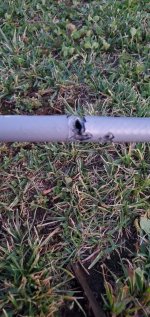Terry I agree. If it wasn't for the contour of some barrels you can cut the breech end off and set the barrel back and get more use out of the barrel. A few issues come up with most people. Just cutting off the breech threads and setting the barrel back say .75" to 1" you do get into cleaner rifling but the wear/damage to the barrel is further up than that. So I'm just picking rough numbers here.... if you got 1500 rounds out of that 300wm barrel the first time... your not going to get another 1500 out of the set back. If I had to pick a rough number I'd say 300ish rounds.
Other issues... depending on the contour will it fit/match up in the barrel channel?
And your losing the length of the barrel.
On one of the barrels that I got back from a bullet maker used for accuracy testing 30cal bullets.... you would have to cut off a solid 6" of barrel to get into nice clean rifling. So on a 26" barrel (see the attached pic) you will end up with 20" finish length on the set back. This was a 308win accuracy test barrel. It went 14,560 rounds and held .5moa or better up until that point. I'd say the first solid 1.5" of rifling in front of the chamber is almost completely gone. 1/3 of the barrel life of this barrel got 200+gr weight bullets fired thru it. Other wise it had 175gr bullets shot thru it.
So I did ask the lab guys that were here today (we didn't get to finish the conversation but I'll be seeing them two more times this week) do longer bullets shorten barrel life. The answer was yes it does. Even running it at the same chamber pressure. Again we have to finish talking some more about it.
For rough numbers they have had our barrels go 19k, 22k and the last one gave up the ghost at 27k + rounds (I'm going to call these freaks and out of the ordinary) but these barrels where getting only 150 to 175gr bullets fired thru them. So if the barrel in the picture that got 5k rounds of the really hvy bullets fired thru it and only went 14k vs the others... that does show that the longer heavier bullets do chew up the barrels faster.
View attachment 8479093


